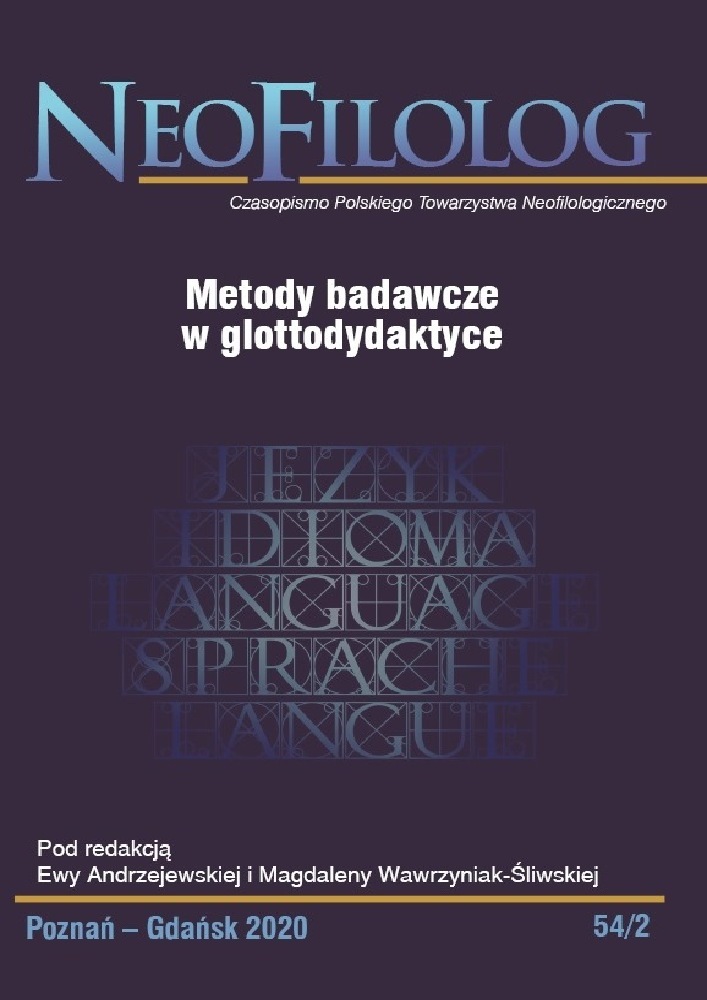Abstract
The aim of this paper is to evaluate implicit and explicit knowledge among Polish speaking students studying French as a foreign language in the academic environment. In the first part, we discuss a timed grammaticality judgment test (TGJT) as an instrument for measuring implicit knowledge and an untimed grammaticality judgment test (UGJT) as a tool for evaluating explicit knowledge and we propose solutions to sidestep some of the weaknesses of both these instruments which were observed in our research. The second part focuses on the presentation of the research results, leading to the conclusion that the group of students at A2 level develop implicit and explicit knowledge in a fairly balanced way
References
Bajrić S. (2005), Question d’intuition. Langue française No 147, p. 7-18. Online : http://www.persee.fr/doc/lfr_0023-8368_2005_num_147_1_6860 [accès : 20.05.2020].
Barth B.-M. (2002), Le savoir en construction. Paris : Retz.
Burston M. (2008), Évaluer la compétence par un test de jugement de grammaticalité : le cas de la relativisation chez des apprenants chypriotes hellénophones avancés en FLE, in : Durand J. Habert B., Laks B. (réd.), Collection des Congrès Mondiaux de Linguistique Française, Paris, France 2008, 1791-1803. Online : https://www.researchgate.net/publication/45069247_Evaluer_la_competence_par_un_test_de_jugement_de_grammaticalite_le_cas_de_la_relativisation_chez_des_apprenants_chypriotes_hellenophones_avances_en_FLE [accès : 09.11.2019].
Chomsky, Noam. (1965). Aspects of the Theory of Syntax. Cambridge : Massachusetts : MIT Press.
Cuq J.-P. (réd.) (2003), Dictionnaire de didactique du français langue étrangère et seconde. Paris : Cle International.
Derkx V. (2015), L’intuition en sciences du langage : de l’énonciation à la grammaticalité des énoncés. Thèse de doctorat en linguistique non publiée. Paris.
Dubois J. (réd.), (2012), Dictionnaire de linguistique et des sciences du langage. Paris : Larousse.
Gombert J.E., Gaux, Ch., Demont, E. (1994), Capacités métalinguistiques et lecture, quels liens ? (in) Repères. Recherches en didactique du français langue maternelle nr 9, p.61-73. Online : https://www.persee.fr/doc/reper_1157-1330_1994_num_9_1_2111 [accès: 09.11.2019].
DeKeyser R.M. (2005), Implicit and explicit learning (in) : C.J. Doughty, M.H. Long (réd.), The Handbook of Second Language Acquisition. Oxford : Blackwell, p. 313-348.
Elder C. (2009), Validating a Test of Metalinguistic Knowledge (in) R. Ellis, S. Loewen, C. Elder, R. Erlam, J. Philp & H. Reinders (réd.), Implicit and Explicit Learning, Knowledge and Instruction. Bristol: Multilingual Matters, p.113-138.
Ellis, R. (2009), Implicit and Explicit Learning, Knowledge and Instruction (in) R. Ellis, S. Loewen, C. Elder, R. Erlam, J. Philp & H. Reinders (réd.), Implicit and Explicit Learning, Knowledge and Instruction. Bristol: Multilingual Matters, p. 3-25.
Han Y. (2000), Grammaticality judgment tests: How reliable and valid are they ? (in) ,,Applied Langauge Learning” nr 11(1), p. 177-204.
Kim M. (2010), The effects of storytelling on adults English language learners (in) ,,Linguistic Research” nr 27 (3), p. 447-473.
Loewen C. (2009), Grammaticality Judgment Test and the Measurement of Implicit and Explicit L2 Knowledge (in) R. Ellis, S. Loewen, C. Elder, R. Erlam, J. Philp & H. Reinders (réd.), Implicit and Explicit Learning, Knowledge and Instruction. Bristol : Multilingual Matters, p. 94-112.
Nadeau M., Fisher C. (2011). Les connaissances implicites et explicites en grammaire : quelle importance pour l’enseignement ? Quelles conséquences ? (in) ,,Bellaterra Journal of Teaching & Learning Language & Literature” Vol. 4 (4), p.1-31. Online : https://www.researchgate.net/publication/277225020_Les_connaissances_implicites_et_explicites_en_grammaire_quelle_importance_pour_l'enseignement_Quelles_consequences [accès: 09.11.2019].
Piegzik W. (2019), La construction des connaissances implicites et explicites en langue étrangère : vers un développement harmonieux ou déséquilibré ? Cas des étudiants polonophones étudiants en FLE développant le plurilinguisme (in) : M. C. Ainciburu (réd.), En camino hacia el plurilingüismo. Actos del IV Congreso Internacional Nebrija en Linqűística Aplicada a la Enseñanza de Lenguas, Madrid : Universidad Nebrija,163-174. Online :
https://www.nebrija.com/vida_universitaria/servicios/pdfpublicaciones/ActasIVCongresoSLANebrija.pdf [accès: 09.01.2020].
Polański K. (red.) (2003), Encyklopedia językoznawstwa ogólnego, Wrocław: Ossolineum.
Tardif J. (1992), Pour un enseignement stratégique : apport de la psychologie cognitive. Montréal : Les Éditions Logiques.
Wilczyńska W., Michońska-Stadnik A. (2010), Metodologia badań w glottodydaktyce. Wprowadzenie. Kraków: Avalon.
Yaguello M. (1988), Catalogue des idées reçues sur la langue. Paris : Éditions du Seuil.
License
Copyright (c) 2020 Neofilolog

This work is licensed under a Creative Commons Attribution-NoDerivatives 4.0 International License.
Authors
Authors of texts accepted for publication in Neofilolog are required to complete, sign and return to the Editorial team’s office the Agreement for granting a royalty-free license to works with a commitment to grant a CC sub-license.
Under the agreement, the authors of the texts published in Neofilolog grant Adam Mickiewicz University in Poznań a non-exclusive, royalty-free license and authorize the use of Attribution-NoDerivatives 4.0 International (CC BY-ND 4.0) Creative Commons sub-license.
The authors retain the right to the free disposal of the work.
Users
Interested Internet users are entitled to use works that have been published in Neofilolog since 2017, under the following conditions:
▪ attribution – obligation to provide, together with the distributed work, information about the authorship, title, source (link to the original work, DOI) and the license itself.
▪ no derivatives – the work must be preserved in its original form. Without the author's consent, it is not possible to distribute the modified work in the form of translations, publications, etc.
Copyrights are reserved for all texts published since 2017.
Miscellaneous
Adam Mickiewicz University in Poznań retains the property right as a whole (layout, graphic form, title, cover design, logo etc.).

